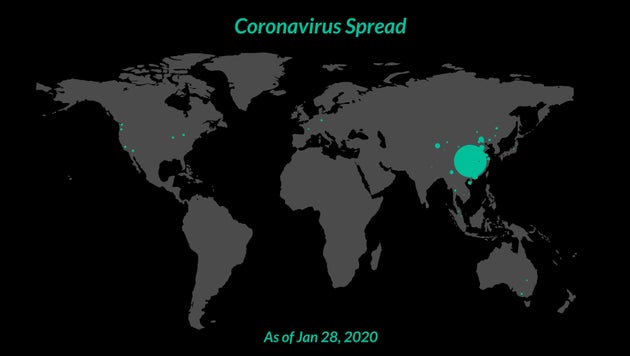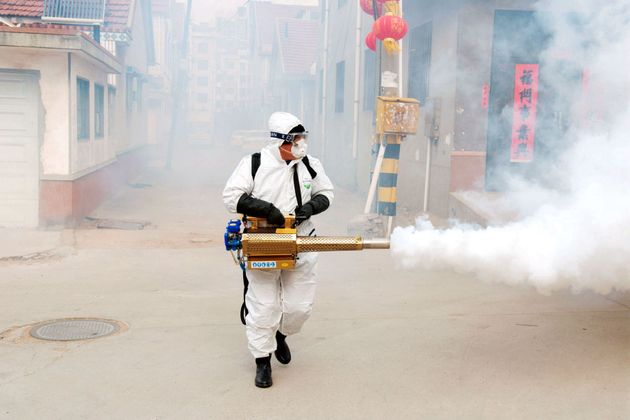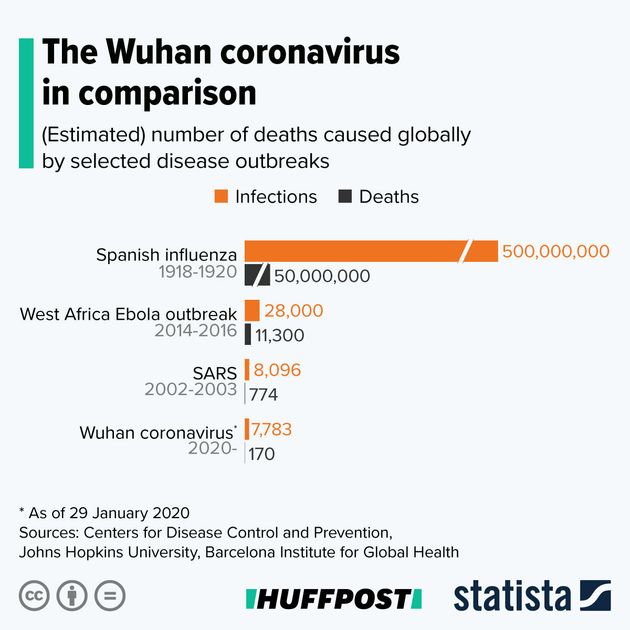
The death toll from the coronavirus has risen to 170, and there are now nearly 8,000 confirmed infections worldwide.
Governments around the world – including the UK – are scrambling to both prevent the disease spreading and to repatriate their citizens currently stranded in the Chinese city at the epicentre of the outbreak.
Britons returning to the UK on Thursday aboard hastily arranged flights will be made to sign forms stating that they agree to being quarantined on a military base for two weeks.
All in all, there is quite the global crisis on the boil. But how bad is it really?

For context, here’s how it stacks up to previous deadly outbreaks.
Let’s start with the latest on Coronavirus.
At the time of writing, 170 people – all in China – have died in the latest outbreak and there are about 8,000 reported cases of infection.
More than 50 infections have been confirmed outside China, including Germany and France.
Its symptoms, including cough and fever and in severe cases pneumonia, are similar to many other illnesses.
A WHO panel of 16 independent experts twice last week declined to declare an international emergency.
You may have noticed that coronavirus has been compared a lot to SARS, and for good reason: SARS was in fact a coronavirus.
Confused? Don’t be. Coronavirus is actually a family of viruses that includes the common cold.
This current outbreak of coronavirus was temporarily named “2019-nCoV” but that doesn’t roll off the tongue quite as easily, so the generic family name has stuck.
SARS
Severe Acute Respiratory Syndrome (SARS) was responsible for a global outbreak between November 2002 and July 2003. It was very similar to the current coronavirus. Crucially, while it was less infectious, it was also deadlier.
This can been seen in the chart below – while cases of coronavirus are already fast approaching the number of reported SARS cases, the death toll is far behind the 774 people who died in that outbreak.

It’s difficult to compare the number of deaths during the SARS outbreak after the same amount of time the coronavirus has been active as Chinese authorities withheld information – a lesson they appear to have learned this time around.
No further cases of SARS have been reported since 2004.
Ebola
While the symptoms of SARS and coronavirus could be confused with a case of the flu, those of ebola most certainly can not.
The virus severely affects the blood’s ability to clot, leading to often fatal uncontrolled bleeding.
As you can see from the chart above, it is far deadlier than coronavirus and during the West Africa outbreak between 2014-16 almost 50% of cases were fatal.
Only a global concerted effort led by the World Health Organization stopped the virus from spreading beyond the African continent, although isolated cases such as Scottish nurse Pauline Cafferkey did slip through the net.
Spanish Influenza
To put all of these into perspective, it’s necessary to hark back to 1918.
Not only was humanity dealing with what was then by far the most deadly war in history, but an outbreak of influenza spread around the world and killed around 5% of the entire world’s population – some 50m people.
There was barely a corner of the world unaffected with cases reported on remote islands in the pacific and even the Arctic.
What was particularly terrifying about this strain of the flu virus was that it was especially lethal for those in the normally healthy age bracket of 20-40 years.
Medicine was obviously more primitive 100 years ago and there was no WHO to coordinate a response, but scientists still aren’t quite sure why it was so devastating.
(CORRECTION: An earlier version of this article incorrectly stated total deaths during the Spanish influenza were around 500 million. This should have been around 50 million)